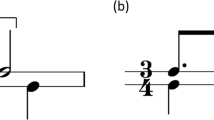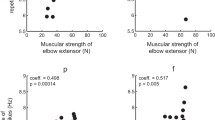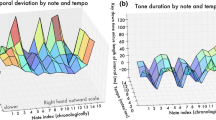Abstract
We report here a preliminary study of interactive behavior between two members of a skilled string quartet performing a selected musical passage that required both performers to play several hundred notes in rapid succession at a steady tempo and in synchrony. Bowing movements were recorded using angular velocity sensors attached to their right forearms. The results show a high degree of temporal precision in both players. In addition, both players exhibited embedded rhythmic components in their timekeeping pattern, which arose from the grouping of notes in the musical score: four 16th notes to a beat. Within each group of four notes, we found a consistent timing microstructure: alternate upbows and alternate downbows had different mean durations. Both players’ bowings could be modeled as alternating renewal processes. In addition, we report evidence of interactive coupling between the players as an essential component of their joint performance. The alternating renewal model enables us to propose a note-generation process that has implications for the central generators underlying the observed behavior and their hierarchical organization. We discuss the implications of this model for the organization and execution of more complex motor sequences.
Similar content being viewed by others
References
Aschersleben G, Prinz W (1995) Synchronizing actions with events: the role of sensory information. Percept Psychophys 57: 305–317
Billon M, Semjen A (1995) The timing effects of accent production in synchronization and continuation tasks performed by musicians and nonmusicians. Psychol Res 58: 206–217
Billon M, Semjen A, Stelmach GE (1996) The timing effects of accent production in periodic finger-tapping sequences. J Mot Behav 28: 198–210
Chatfield C (1984) The analysis of time series. Chapman & Hall, London
Chen J, Woollacott M, Pologe S, Moore GP (2008) Pitch and space maps of skilled cellists: accuracy, variability and error correction. Exp Brain Res 188: 493–503
Collyer CE, Church RM (1998) Interresponse intervals in continuation tapping. In: Rosenbaum DA, Collyer CE (eds) Timing of behavior. Neural, psychological and computational perspectives. MIT Press, Cambridge, pp 63–87
Cox DR (1962) Renewal theory. Methuen & Co., London
Cox DR, Lewis PAW (1966) The statistical analysis of series of events. Methuen & Co., London
Epstein D (1995) Shaping time: music, the brain and performance. Schirmer Books, New York
Goebl W, Palmer C (2009) Synchronization of timing and motion among performing musicians. Music Percept 26(5): 427–438
Hary D, Moore GP (1985) Temporal tracking and synchronization strategies. Hum Neurobiol 4: 73–79
Hary D, Moore GP (1987a) Human processing of temporal information. Biol Cybern 56: 305–311
Hary D, Moore GP (1987b) On the performance and stability of human metronome-synchronization strategies. Br J Math Stat Psychol 40: 109–124
Keller PE, Knoblich G, Repp BH (2007) Pianists duet better when they play with themselves: on the possible role of action simulation on synchronization. Conscious Cogn 16: 102–111
Mates J (1994a) A model of synchronization of motor acts to a stimulus sequence. I. Timing and error corrections. Biol Cybern 70: 463–473
Mates J (1994b) A model of synchronization of motor acts to a stimulus sequence. II. Stability analysis, error estimation and simulations. Biol Cybern 70: 475–484
Mates J, Radil T, Pöppel E (1992) Cooperative tapping: time control under different feedback conditions. Percept Psychophys 52: 691–704
Perkel DH, Gerstein GL, Moore GP (1967) Neuronal spike trains and stochastic point processes. I, II. Biophys J 7: 391–440
Rasch RA (1979) Synchronization in performed ensemble music. Acustica 43: 121–131
Repp BH (2001a) Phase correction, phase resetting, and phase shifts after subliminal timing perturbations in sensorimotor synchronization. J Exp Psychol Hum Percept Perform 27: 600–621
Repp BH (2001b) Processes underlying adaptation to tempo changes in sensorimotor synchronization. Hum Mov Sci 20: 277–312
Repp BH (2002) The embodiment of musical structure: effects of musical context on sensorimotor synchronization with complex timing patterns. In: Prinz W, Hommel B (eds) Common mechanisms in perception and action: attention and performance XIX. Oxford University Press, Oxford, pp 245–265
Schögler B (1999) Studying temporal coordination in jazz duets. Musicae Scientiae. Special issue (1999–2000):75–91
Semjen A, Vorberg D, Schulze HH (1998) Getting synchronized with the metronome: comparisons between phase and period correction. Psychol Res 61: 44–55
Semjen A, Schulze HH, Vorberg D (2000) Timing precision in continuation and synchronization tapping. Psychol Res 63: 137–147
Shaffer H (1984a) Timing in musical performance. Ann N Y Acad Sci 423: 420–428
Shaffer H (1984b) Timing in solo and duet piano performances. Q J Exp Psychol 36A: 577–595
Strogatz SH, Stewart I (1993) Coupled oscillators and biological synchronization. Sci Am 269: 102–109
Author information
Authors and Affiliations
Corresponding author
Rights and permissions
About this article
Cite this article
Moore, G.P., Chen, J. Timings and interactions of skilled musicians. Biol Cybern 103, 401–414 (2010). https://doi.org/10.1007/s00422-010-0407-5
Received:
Accepted:
Published:
Issue Date:
DOI: https://doi.org/10.1007/s00422-010-0407-5




